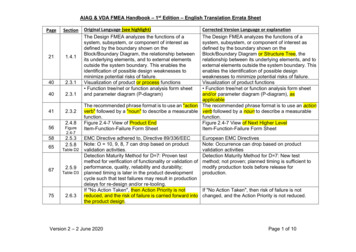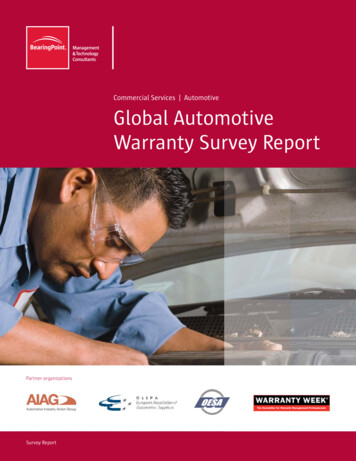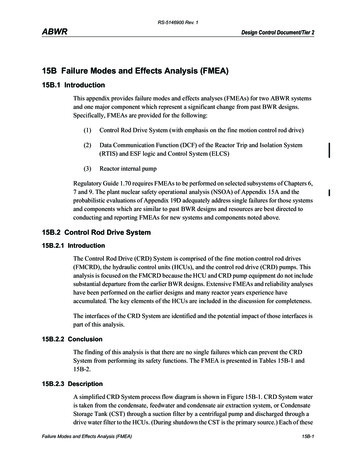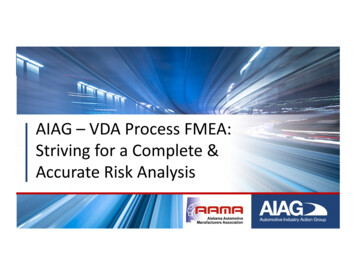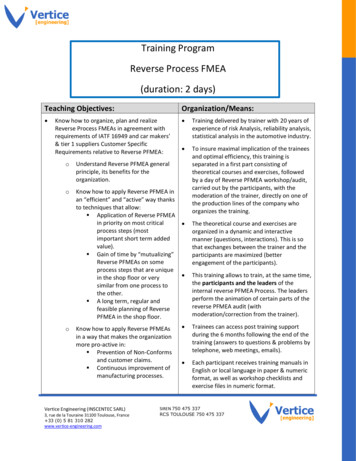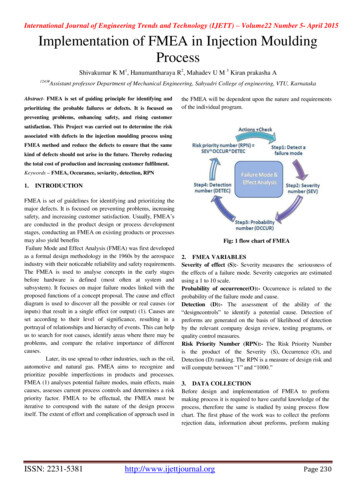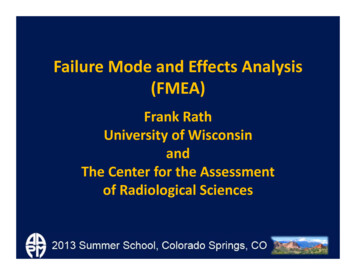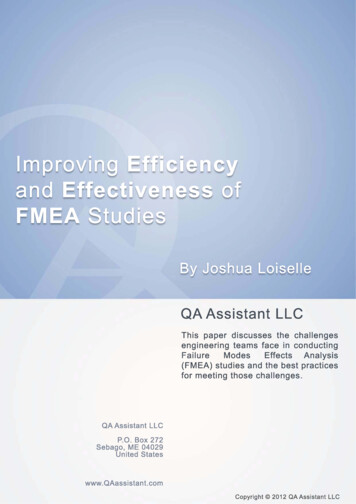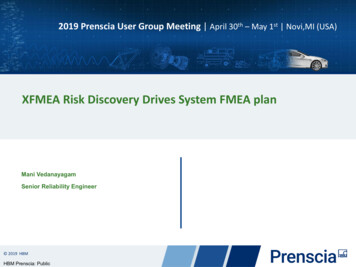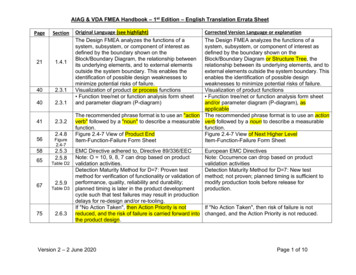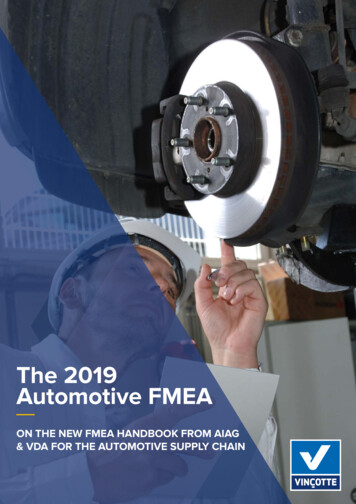
Transcription
The 2019Automotive FMEAON THE NEW FMEA HANDBOOK FROM AIAG& VDA FOR THE AUTOMOTIVE SUPPLY CHAIN
WHY THIS PAPERFor automotive manufacturing suppliers, technical risk analyses (regarding both design andmanufacturing processes) are a mandatory part for automotive QMS certification IATF 16949,and the tool to manage those risks is the FMEA method. To conduct such risk analysis inpractice, there's a specific reference manual among the set of books on automotive coretools, the so-called Blue Books (APQP, PPAP, MSA, SPC, and FMEA). The previous edition ofthe FMEA manual – "Potential Failure Mode and Effects Analysis (FMEA), Reference Manual,Fourth Edition, June 2008" – is now being replaced by a new joint publication from AIAG andVDA: the "AIAG & VDA FMEA Handbook, First Edition, June 2019." In this introductory paper, wesummarize the changes and highlight what's new: a new analytical method, a new rating scaleand new formats.This introduction is intended for 2Automotive suppliers certified IATF 16949;Automotive QMS trainers, consultants, (internal) auditors, etc.;Automotive suppliers working towards IATF 16949 certification;Anyone interested in the newest automotive FMEA tools.
AN IMPROVED FMEA APPROACHIn today's context, automotive suppliers are confronted, more than ever, with a multitudeof difficult product demands: higher quality, higher reliability, higher complexities (includingincreasing electronics and software demands), increasing regulations, with on top of all theneed for further cost reduction. The new FMEA handbook is the result of a joint effort from theAutomotive Industry Action Group (AIAG) and the Verband der Automobilindustry (VDA). Theirintension being not only to improve the FMEA development process, but also to harmonizedifferent regional versions into one single manual, providing a best-practice process approachto meet industry requirements, in particular for automotive suppliers.3
AN IMPROVED FMEA APPROACHTo address technical risks and increase safety, during both design development activities andprocess development activities the FMEA method is used as living tool throughout the product/process realization process. FMEA is a multi-disciplinary (i.e., composed of the necessarydifferent subject matter expertise), analytical, systematic method on system, subsystem, orcomponent level in order to: list potential technical failures of a product, from design point of view; list potential technical failures of a process, from manufacturing point of view; analyze the potential causes and effects of such failures; recommended actions and/or controls to further mitigate, prevent, detect those potentialfailures.Important here is that the FMEA activity should start early in the process of design developmentand process development respectively. Thus, reflecting from the beginning of the productdesign on what could go wrong if designed in a particular way. Then, ideally before actuallybuying/installing production equipment, reflecting on what could go wrong in the choices of theway of manufacturing.And last but not least, FMEA is not supposed to be just a one-time exercise, but is to bereviewed in due time as product design and processes design evolve and mature. The FMEAreport evolves into a living document, and therefore is an iterative process.4
THE CHANGESLet's first recap what hasn't changed.The starting and preparation principles still hold. Before proceeding to the actual technicalpart, considering technical risks and how to minimize or avoid them, the FMEA team shouldbegin with, as ever: identify the project (i.e.,what exactly are we going to examine?), gather allinformation needed, draw up the project planning, set analysis boundaries (what is includedversus what is excluded),and set the FMEA baseline (from earlier Lessons Learned – remember:FMEAs are also supposed to serve as written technical notes about what may have gone wrongin the past and how it was addressed).At the onset of the FMEA project, the starting point is the project planning, containing thetopics as guided by the so-called Five T's: Intent, Timing, Team, Task, Tool. These principlesremain. Namely, that team members do know the FMEA method, their role in the team and howto conduct such an exercise. That an FMEA should be conducted up front, according to theproject plan and not afterwards after the facts, for instance to complete the documentation. Thatthe team needs to be cross-functional, i.e. that all necessary expertise is represented by meansof subject experts. That a framework is available for tasks and deliverables, and their follow-up.That all the team members possess the knowledge to use the selected FMEA tools or software.Hence for successful and useful completion, the FMEA team should be led by an experiencedFMEA facilitator/leader.Now, what has changed?The main change is the introduction of a 7-step approach, a new framework to investigatefailure modes and its potential causes following a process consisting of seven steps. Thisapproach serves as a structured method to describe more precisely potential technical risksand their consequences.The seven steps are:Step 1 : Planning & PreparationStep 2 : Structure AnalysisStep 3 : Function AnalysisStep 4 : Failure AnalysisStep 5 : Risk AnalysisStep 6 : OptimizationStep 7 : Results Documentation5
The objective of each of these steps is as follows:The purpose of Step 1, Planning & Preparation, is to define whichFMEAs will be done throughout the project, of what type (system,subsystem, component), and what will be included and excludedrespectively. During this phase, the details of project planning areworked out.During Step 2, Structure Analysis, the scope of the FMEA isdefined. This can be achieved using a variety of tools and/orvisualizations: structure trees, block diagrams, boundary diagrams,physical parts, interface analyses, interaction analyses, etc.The purpose of Step 3, Function Analysis, is to make sure that thefunctions specified by the technical specifications or requirementsare fully understood, completely defined, and assigned to systemelements. And that no functional items are missing. Useful tool:a parameter diagram (or P diagram), where parameters are theattributes of behavior of a function.During Step 4, Failure Analysis, the actual potential causes, modes,and effects of technical failures are considered. The differenttypes of failures modes and failure chains are to be evaluated andanalyzed. Deep technical dive regarding what could go wrong, why,and how it would show or manifest.In Step 5, Risk Analysis, the risk levels of the identified potentialfailures are assessed with regards to severity (S), occurrence (O),and detection (D). Subsequently, necessary actions are defined, andtheir priority. The idea is to identify what to address first, but keepingawareness of the lower-rated risks where no immediate action wasdecided.The purpose of Step 6, Optimization, is to assess the effectivenessof the previously defined actions to mitigate the identified risks. Thatis, review if previously defined actions did indeed give the desiredresults and decide if yes/no adjustments are in order.And finally Step 7, Results Documentation, which goal is tosummarize and communicate the FMEA activities. In short, write andupdate the FMEA report as the project evolves.The handbook provides templates and examples regarding thedifferent successive steps.6
Another change: AP replaces RPN.Instead of Risk Priority Numbers (RPN) to rate Severity, Occurrence,and Detection, ranked after multiplication of the respective ratingnumbers, a new method is introduced: Action Priority (AP) levelswith the possible rankings High, Medium, or Low. Given real-lifelimitations in time and resources, one must make choices regardingpriorities and actions, hence ranking in a more pragmatic mannerper the high-medium-low philosophy.Furthermore, another new method is introduced in the new FMEAHandbook, called the Supplemental FMEA for Monitoring andSystem Response (FMEA-MSR): a new way for analysis of diagnosticdetection and fault mitigation, that is assessment of potential failuresunder customer operation (i.e., at end-user or in-service stage).Three categories of risks are to be assessed: Severity (S) of harm, loss of or degraded functionality,unacceptable quality, or regulatory noncompliance; Frequency (F) estimation of the potential failure in operationalcircumstances; Monitoring (M): possibilities for detection followed by automatedresponse to limit or avoid a failure effect.7
TRANSITIONING TO THE NEW FMEA METHODImportant note: The new FMEA Handbook allows organizations to maintain existing FMEAs intheir original form for subsequent revisions (see Section 1.3.5 in Handbook), but new projectsmust follow the new FMEA methodology. So, no need to "reformat" all current existing FMEAs,but if you start a new design development process or manufacturing development process, thenew FMEA approach is to be used.IN SUMMARYUsing the revised and extended FMEA method, bringing together bestpractices from separate manuals into one handbook, should result inan improved comprehension and mastery of the technical risks, whichin turn leads to increased performance and thus ultimately increasedcustomer satisfaction. The new FMEA tool is a new opportunityand interesting instrument to further advance and put continualimprovement into practice.8
WHAT WE OFFERBased on our extensive experience in automotive auditing and history as IATF CertificationBody, we offer multiple options to help you gain accelerated understanding of and insightinto the new FMEA method. We cover what has changed, why it has changed and how to getstarted with this new tool in practice.You can choose from:(1) An introductory, more general, information session with Q&A;(2) A customized session to dive into company-specific FMEA cases and examples;(3) On-site assistance in conducting FMEA exercises according to new method;(4) On-demand, individualized trajectories to implement the new FMEA approach.THE SEVEN FMEA STEPSPlanning timization79
Verantwoordelijke uitgever: Jos Windey Jan Olieslagerslaan 35 1800 VilvoordeMaatschappelijke zetelJan Olieslagerslaan 351800 VilvoordeTel: 32 2 674 57 11OfficesJan Olieslagerslaan 351800 VilvoordeTel: 32 2 674 57 11brussels@vincotte.beNoordersingel 232140 AntwerpenTel: 32 3 221 86 11antwerpen@vincotte.beRue Phocas Lejeune 115032 GemblouxTel: 32 81 432 611gembloux@vincotte.beBollebergen 2a bus 129052 GentTel: 32 9 244 77 11gent@vincotte.beTechnical Training CenterLeuvensesteenweg 248 ATel: 32 2 674 58 571800 Vilvoordeacademy@vincotte.bevincotte.be
Automotive FMEA ON THE NEW FMEA HANDBOOK FROM AIAG & VDA FOR THE AUTOMOTIVE SUPPLY CHAIN. 2 WHY THIS PAPER For automotive manufacturing suppliers, technical risk analyses (regarding both design and manufacturing processes) are a mandatory part for automotive QMS certification IATF 16949, and the tool to manage those risks is the FMEA method. To conduct such
